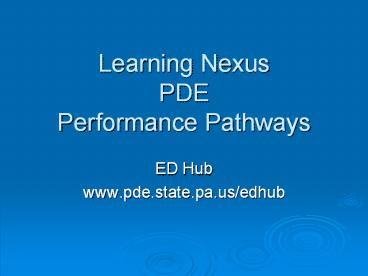Learning Nexus PDE Performance Pathways PowerPoint PPT Presentation
1 / 25
Title: Learning Nexus PDE Performance Pathways
1
Learning NexusPDE Performance Pathways
- ED Hub
- www.pde.state.pa.us/edhub
2
Data drives your decisions
Core curriculum
Diary Maps
State and National
Benchmarks
Curriculum Data Aligned to Standards
Assessment Data Aligned to Standards
Data Analysis
Data Analysis
A Data-Informed Culture
Improve Student Achievement
3
Bridging the Gap
State Assessment PSSA
PA Curriculum Framework
Anchors
Anchors
Local Assessment 4Sight
District Curriculum - Lesson Plans
Anchors
Data-Driven Culture
Data-Driven Culture
4
What do we do next?
5
Where do we go next? Bridge the Gap
- Assessment Data
- Analysis of performance
- based on anchors
- Curriculum
- Data
- Analysis of
- Curriculum based on anchors
6
How does curriculum become data?
7
What is Curriculum Mapping?
- Calendar based curriculum mapping is a procedure
for collecting a data base of the operational
curriculum in a school and/or district. - It provides the basis for authentic examination
of that data base. - Using an electronic, shared relational data base
provides the basis for a learning community
Based on the work of Heidi Hayes Jacobs Mapping
the Big Picture, ASCD
8
What is Content?
- usually stated as nouns
- focused on the important concepts and ideas
9
Skills
- Precise skills can be
- Assessed
- Observed
- Described in specific terms
- Skills contain action verbs
- Skills are always associated with content
10
PDE Learning Nexus
11
District Curriculum
12
Using the Learning Nexus to Build
Written Curriculum
CORE Maps for each course
Taught Curriculum
Teacher lesson plans
13
- When building curriculum pay attention to the
level of thinking required
14
The Three Story Intellect
- There are one-story intellects, two story
intellects, and three-story intellects with
skylights. All fact collectors, who have no aim
beyond their facts, are one-story men. - Two-story men compare, reason, generalize, using
the labors of the fact collectors as well as
their own. - Three-story men idealize, imagine, predict--their
best illumination comes - from above, through the skylight.
Oliver Wendell Holmes
15
The Three Story Intellect
Complete Identify Observe Input
Count List Recite Input
Define Match Select Input
Describe Name Scan Input
16
The Three Story Intellect
Compare Distinguish Analyze Process
Contrast Explain Synthesize Process
Classify Infer Make analogies Process
Sort Sequence Reason Process
Complete Identify Observe Input
Count List Recite Input
Define Match Select Input
Describe Name Scan Input
17
The Three Story Intellect
Evaluate Predict Hypothesize Output
Generate Speculate Forecast Output
Imagine If/then Idealize Output
Judge Apply a principle Output
Compare Distinguish Analyze Process
Contrast Explain Synthesize Process
Classify Infer Make analogies Process
Sort Sequence Reason Process
Complete Identify Observe Input
Count List Recite Input
Define Match Select Input
Describe Name Scan Input
18
Learning NexusAssessment Anchor R7.B.2
19
Turn to a partner
- What are the words or ideas that you associate
with imagination?
20
Objectives Objectives
Students will be able to Identify, interpret, describe, and analyze figurative language in fiction and nonfiction.Content metaphor, simile, personification, imagery
Activities Activities
Begin with question What words do you associate with imagination? This activity will help students tune in to the story.Read the book aloud stopping along the way for students to analyze the text and the use of language and illustration in the text.Challenge for students Write a story or book that imagines a day and illustrate the book or story. What book "...swings open on silent hinges..." for you? Why? Be prepared to share your thoughts in a literature circle and show how the author captured your imagination with references to the literary devices in the text.
Resources Materials Resources Materials
Imagine a Day--written by Sarah L. Thomson and paintings by Rob Gonslves
Differentiated Differentiated
This lesson is differentiated as students develop their own application of the use of literary devices to both write and illustrate their stories.Students will be evaluating the successful use of devices once they have chosen the book that opens a door for them. They will need to justify their answers with examples from the text.
21
Assessment For Learning
- Clearly understand the standard
- Deconstruct into enabling achievement targets
Learning Nexus - Create a student friendly version of targets I
can statements - Create high quality assessments of targets
Ongoing benchmarks/4sight - Use assessments in collaboration with students to
track improvement Self Assessment
Rick Stiggins Student- Involved Classroom
Assessment
22
M3.D.1 - Demonstrate an understanding of
patterns, relations and functions.
23
Grade 3 Patterns and Relations Name
________________
Learning Outcomes Evidence Date
I can extend or find a missing element in a pattern Create a pattern with buttons. Partner with another student and give them the challenge to extend your pattern. Leave one element of your pattern out and challenge your partner to fill in the missing element. Now reverse and have your partner challenge you. Each of you should write your reasoning to show how you solved the problems presented. What was the rule for the pattern?
24
Bridging the Gap
State Assessment PSSA
PA Curriculum Framework
Anchors
Anchors
Local Assessment 4Sight
District Curriculum - Lesson Plans
Anchors
Data-Driven Culture
Data-Driven Culture
25
FEEDBACK SPIRAL
Study / Reflect /Evaluate
Assess andGather Evidence
Take Action/Experiment
Plan
Clarify (Revisit)Goals and Purpose
Modify Actions Basedon New Knowledge
Study / Reflect /Evaluate
Assess / Gather Evidence
From Assessment in the Learning Organization,
Shifting the Paradigm Page 27 - Edited by Arthur
L. Costa and Bena Kallick, ASCD 1995

